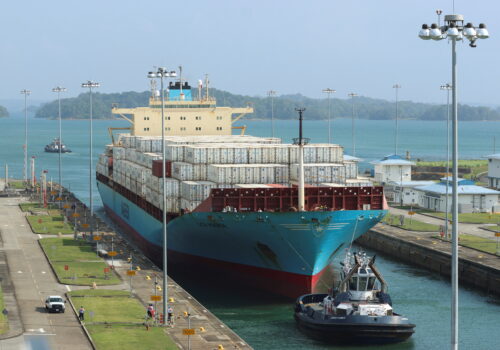Milei came to Washington wanting freer trade. What would that mean for the US and Argentina?
Earlier this month, President Donald Trump announced tariffs on steel and aluminum imports to the United States that will go into effect in March. He has also ordered the preparation of reciprocal tariffs based on the import duties charged by other countries on US goods. Although there is still much uncertainty over what the implementation of these trade measures will look like, many countries, and especially historically protectionist ones such as Argentina, could feel the hit.
Argentina is at a critical moment for the country’s economic stabilization, as Argentine President Javier Milei pushes forward his reform agenda seeking to grow the country’s economy while bringing down inflation. This is a goal that Argentina cannot accomplish on its own. It was no surprise, then, that when Milei visited Washington last week to speak at the Conservative Political Action Conference (CPAC), he also held meetings at the International Monetary Fund and with Trump.
Specifically, Milei used his trip to Washington to underscore his commitment to move Argentina toward a closer trade relationship with the United States. During his speech at CPAC on Saturday, Milei said that Argentina wants to be “the first country in the world to join this reciprocal accord that the Trump administration proposed on trade matters.” Yet despite the clear political and ideological alignment between the two administrations, there are a few bottlenecks for deeper bilateral commercial and investment ties. So, what does the US-Argentina trade relationship look like now and how could the two countries deepen economic opportunities that are mutually beneficial?
The status of US-Argentina commercial ties
The United States has historically enjoyed a structural surplus in bilateral goods exchanges with Argentina. The South American country is a net importer of US machinery, electrical equipment, transportation, pharmaceuticals, plastics, and chemical products. It is also a net exporter of agricultural goods, steel, aluminum, and metals to the US market.
Over the past twenty-four years, Argentina ranks as the tenth-largest country in terms of the total US trade surpluses in goods for the totality of that period, as calculated with US government trade data. Moreover, as the chart below shows, the robustness of US net sales of “machinery, electronics, transportation, and other equipment” has a strong positive correlation with Argentina’s real economic growth. As such, when Argentina’s economy has grown, US net sales of these manufactured goods to Argentina have historically experienced an increase. And this correlation appears even more strongly when it comes to total US sales for these products. Looking forward, there is an opportunity to deepen this dynamic, especially as key sectors such as Argentina’s booming energy industry continue to demand further supplies of US goods.
The United States is Argentina’s main source of foreign direct investment, and US companies stand to gain from moves that ease the flow of supplies from the United States to projects to develop Argentina’s vast natural resources, from oil to lithium. These factors point to the growth potential of closer bilateral trade relations, and it is surely the case that Milei made in his recent conversations with the Trump administration on deepening bilateral economic ties.
The potential of deeper US-Argentina economic relations
As the American Chamber of Commerce in Argentina recently argued, stronger economic ties between Argentina and the United States can help increase the exports of US manufactured goods and build a stronger supply of critical minerals for the United States. This would also further internationalize Argentina’s historically protectionist economy as a means of driving growth. Argentina’s economy is expected to grow between 4 and 5 percent in 2025, which could allow it to recover the lost ground of the 2023-2024 recession. If the Trump and Milei administrations can further build the two countries’ commercial ties, then there is an opportunity for both increased commercial flows and greater, long-lasting US foreign direct investment. To facilitate greater trade, the two administrations will need to work through mechanisms such as their Trade and Investment Framework Agreement.
Addressing bottlenecks to deeper bilateral economic ties can be mutually beneficial. And at a time of great trade policy uncertainty around the world, countries such as Argentina can help reduce, rather than raise, barriers to trade.
The future of US-Argentine commercial relations
Although challenging, there is precedent upon which Trump and Milei could build a closer economic partnership. During Trump’s first term in office, he negotiated quotas for Argentine steel and aluminum exempted from tariffs, lifted a ban on Argentine lemons, and readmitted Argentina as a beneficiary of the US Generalized System of Preferences, which allows a series of select goods from developing countries to access the US market duty-free.
So how should the two administrations proceed today? The government of Argentina is demonstrating a clear willingness to negotiate freer trade with the US. Therefore, the Milei administration should be proactive in its messaging, showing its US counterparts that freer trade with Argentina, and with South America more broadly, is a win-win for both countries. In the end, the United States holds deep trade surpluses with South America as a region, and Milei, who is pushing his Mercosur partners to reduce tariffs and liberalize trade, is aiming for deeper regional commercial ties that are mutually beneficial with the United States. At the same time, Milei’s government will need to be mindful of the potential implications for the EU-Mercosur trade deal that was negotiated this past December, given its enormous potential for Argentina and the risks it still faces during the ongoing ratification and implementation process.
And especially given this process, the Milei administration should continue to work closely with its Mercosur partners. Although Argentina can continue to reduce domestic barriers to trade, including nontariff measures, the country is still subject to Mercosur’s common external tariffs and the bloc’s prohibition for members to negotiate bilateral free trade agreements outside of the customs union. The benefits of the EU-Mercosur agreement are clear to Argentina and the blocs’ other members, and its potential implementation should not deter Argentina from stronger economic ties with the United States.
What should the United States do? In the context of the extensive review of US trade mandated by Trump, the administration should consider the Argentine proposal in the larger context of the administration’s renewed focus on Latin America. The deep and historic trade relations that bind North and South America present ample reasons for the United States to consider further engagement with the region as a means of strengthening hemispheric ties while empowering regional economies, whose growth and stability is aligned with US interests.
Deepening US-Argentine economic ties, and US-South America trade relations, is in both parties’ interests. In the months ahead, Trump and Milei could have the opportunity to set the bilateral relationship on a course for deeper integration.
Ignacio Albe is a program assistant at the Atlantic Council’s Adrienne Arsht Latin America Center.
Valentina Sader is a deputy director at the Atlantic Council’s Adrienne Arsht Latin America Center.
Further reading
Tue, Feb 4, 2025
Where do the Trump tariffs go from here?
Fast Thinking By
US tariffs on China went into effect today, while President Donald Trump paused levies on Mexico and Canada. Our experts explain who and what could be next.
Fri, Jan 31, 2025
Beyond the border: Your briefing on US-Mexico commerce
Beyond the border By
The first edition of the Beyond the border: Your briefing on US-Mexico commerce newsletter.
Mon, Jan 27, 2025
Expert context: What’s going on with Trump and the Panama Canal?
New Atlanticist By
With US President Donald Trump focusing on the critical waterway early in his second term, Atlantic Council experts explain how the canal came about, why it matters today, and what to expect next.
Image: President Donald Trump meets with Argentina’s President Javier Milei at the Gaylord National Resort & Convention Center in Oxon Hill, Maryland, on Saturday, February 22, 2025. (Official White House Photo by Molly Riley)


